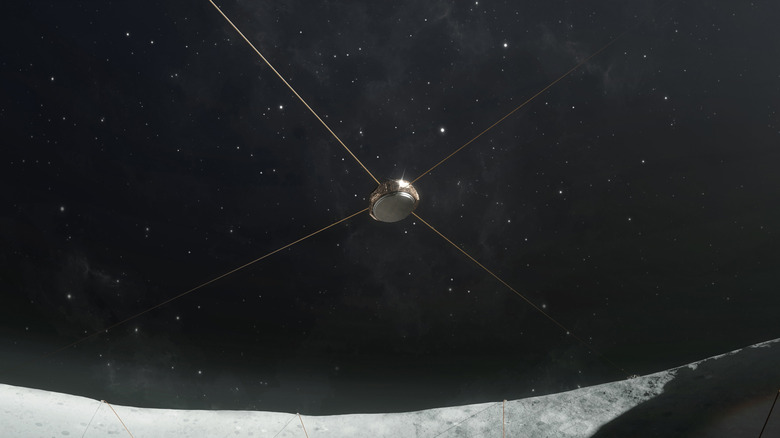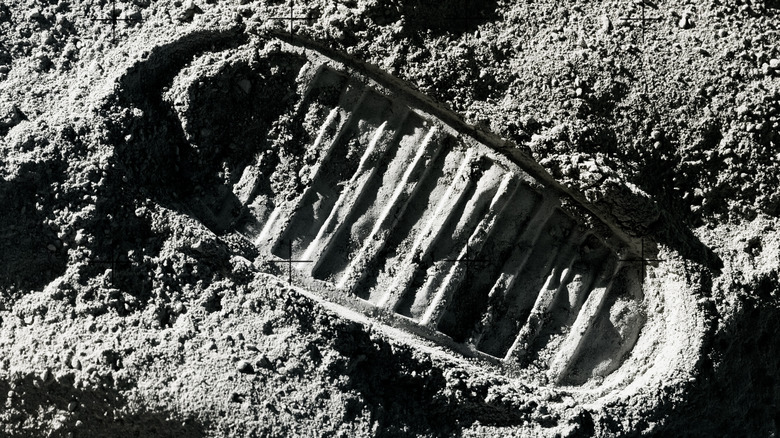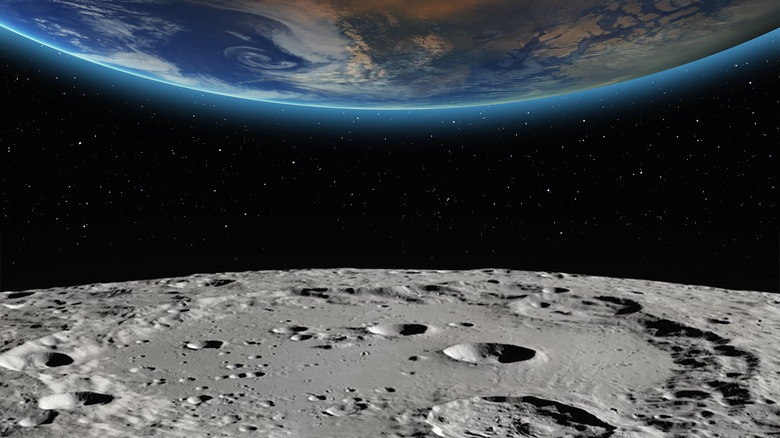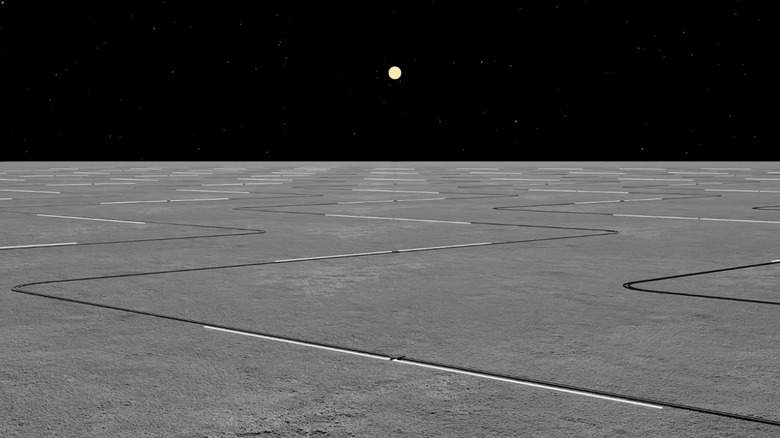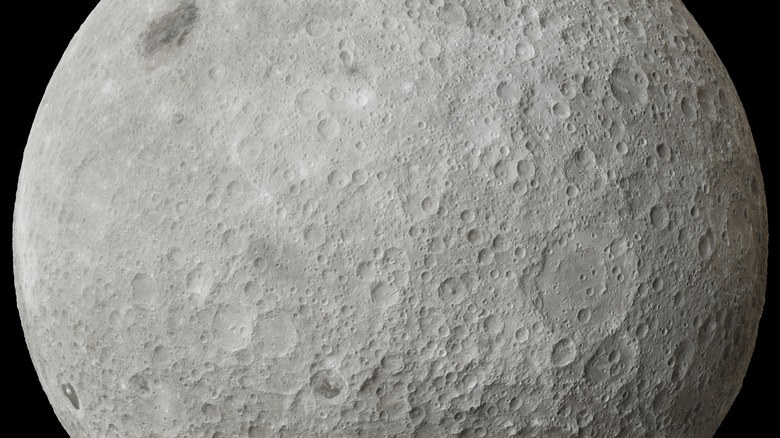Why Scientists Want To Build A Giant Telescope On The Moon
"Because it's awesome" might very well be one of the reasons scientists want to build a giant telescope on the moon, and they wouldn't be wrong; it absolutely would be awesome. Fortunately, there are a lot of practical reasons to observe the cosmos from the surface of Earth's largest satellite too, even if the logistics of getting such an endeavor up and running prove to be a little challenging. Okay, exceptionally challenging, but not insurmountable. We may even see the first major lunar construction project break ground — or is it break regolith? — before the end of the decade.
Space is known to be tough on humans, and it's not any easier on telescopes; the James Webb Space Telescope took $10 billion dollars and more than three decades to go from idea to launch, and before it even completed its instrumentation checks the universe had already started throwing rocks at it. The idea of putting telescopes on the moon has been around for a while though, and engineers have come up with some pretty ingenious methods for working around the unforgiving environment of the lunar surface.
But the question remains: besides the awesome factor, what makes it worth the considerable struggle to put a telescope on the moon? And how exactly can it be done? Let's dive in.
The moon is a harsh construction site
So, what makes it so hard to build on the moon? Well, first of all, it's covered in dust — presumably because it's been a long time since someone's done a thorough cleaning up there. But if you're picturing the same type of substance that accumulates under your sofa, you're in for some bad news. Lunar dust is worse. Much, much worse. This fine granular material has a consistency closer to powdered glass shards, which, as one might imagine, is a serious pain to work with. It's also electromagnetically charged from the unshielded bombardment of solar radiation. The combination of small size, jagged shape, and electric charge causes lunar dust to stick to everything, jamming equipment and causing abrasive damage.
The moon is also subject to a wide range of temperatures, from roughly -200°F to 250°F. And, somewhat paradoxically, a single piece of equipment on the moon could be subject to both ends of this temperature range at the same time. The lack of atmosphere creates extreme temperature differences between direct sunlight and shade. Many materials don't hold up well to this kind of differential and either freeze, melt, crack, or disintegrate.
Then there's the infrastructure on the moon — or, the glaring lack thereof. There's no telescope factory up there. Every nut and bolt, every mirror and cable, and every circuit and processor needed for a lunar telescope would need to be hauled up from Earth, and at last check, this was still an expensive endeavor.
Worth it!
Okay, so why go to all the trouble? As it happens, telescopes on the moon circumvent a lot of problems we encounter with telescopes here on Earth. As covered above, the moon's lack of atmosphere leads to a fair number of headaches, but it also makes for some spectacular views. Sure, Earth's atmosphere is good for life and all, but it also reflects, scatters, or absorbs incoming photons from huge swaths of the electromagnetic spectrum, rendering some types of observations simply impossible. Not so on the moon.
Not only that, but the orbital mechanics and gravitational dynamics between the sun, Earth, and moon lead to some useful conditions. Despite what pop culture has to say about it, there is no "dark side" of the moon. A day on the moon lasts about a month on Earth. This means that nighttime at any given point on the moon — when it's dark and shielded from the interfering radiation of the sun — lasts for a couple of weeks at a time.
On top of this, a telescope on the moon's far side — which always points away from Earth — is permanently shielded from the constant radio interference emitted by human technology. It should also be noted that the moon's lower gravity allows for stable structures that would collapse under their own weight on Earth. Of course, there are other benefits that have more to do with society than strictly the physics of it all. On Earth, mountaintops make a great place to build a telescope from a technical perspective, but this can cause cultural issues that are unlikely on an uninhabited planetary body.
Scientific relevance
Okay, so let's say for a moment that we have our giant telescope on the moon. What are we looking at? Well, why not start at the beginning — the beginning of everything, that is. For millions and millions of years after the Big Bang, the universe was still too dense and energetic to form anything resembling the structure we're familiar with today. The formation of the first stars took a long time, and this is sometimes called the Cosmic Dawn. Everything before this is ominously referred to as the Dark Ages, because, in the time before starlight, it was literally an age of darkness.
We don't really have any good data on the structure of the universe during this time, and that's a shame because we sure have a lot of questions. The distribution of matter within the observable universe today is uneven with dense pockets scattered among vast voids, and we're not really certain why that is. The clues may be hidden away in the Dark Ages, which could be observed with a large enough telescope shielded from the interference caused by the Earth and sun.
It could also be possible for a lunar telescope to detect radio waves coming from exoplanets, specifically Earth-like exoplanets. Earth's magnetosphere has an effect on particles traveling through it, and — with the right equipment — those effects can be detected from far away. Likewise, exoplanets that happen to have magnetic fields should be similarly detectable from a sufficiently designed lunar telescope.
Ingenious solutions
There's still the question of "how," but it's not a question that lacks for answers. One NASA proposal describes the feasibility of a Lunar Crater Radio Telescope, or LCRT. The Arecibo Observatory — perhaps Earth's most iconic radio telescope before its dramatic collapse — was a single-dish radio antenna built into a sinkhole with a receiver suspended above by cables. The LCRT would be similar, but instead of a sinkhole, it would sit in a lunar crater. Instead of a solid dish, it would be made of lightweight mesh that would reflect low-frequency light waves. At a diameter of about 0.6 miles, it would be an impressive sight, but not by any means the largest of the proposed lunar telescopes.
The FarView radio telescope would cover an area roughly the size of Baltimore on the moon's far side with 100,000 flat, sinewave-shaped antennas. This would be accomplished by having autonomous machines extract aluminum from the moon and then manufacture it into long strips. FarView would essentially use the same technology as a handheld radio — albeit a gargantuan one — without having the costs of sending the material from Earth.
Another unique spin on a lunar telescope involves building a receiver dish out of liquid. Yeah, seriously. Such things already exist on Earth and are usually made of mercury. A cylinder containing reflective liquid is rotated, and the liquid inside naturally forms a perfect parabola. Mercury wouldn't handle the lunar temperatures very well, but certain types of molten salts might be able to do the job, thus avoiding the expensive origami folding required of other large space equipment. Which, if any, of these telescope proposals (or others) ever make it to the moon, we'll just have to wait and see.
